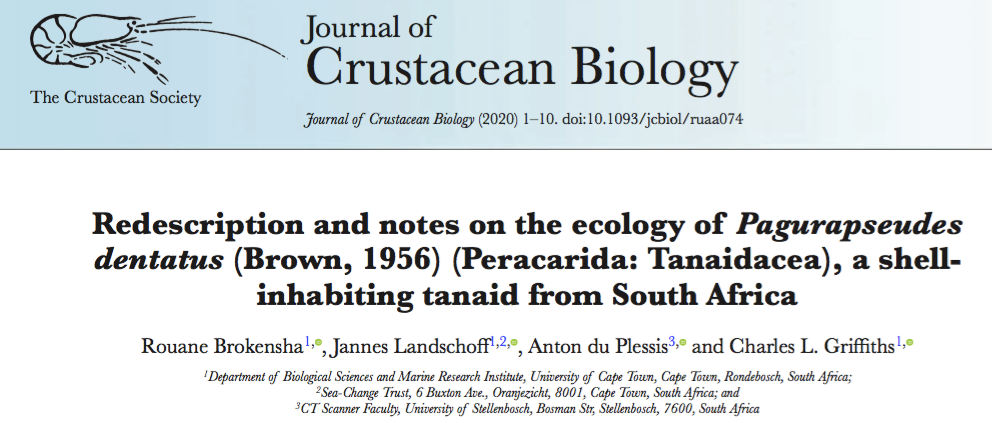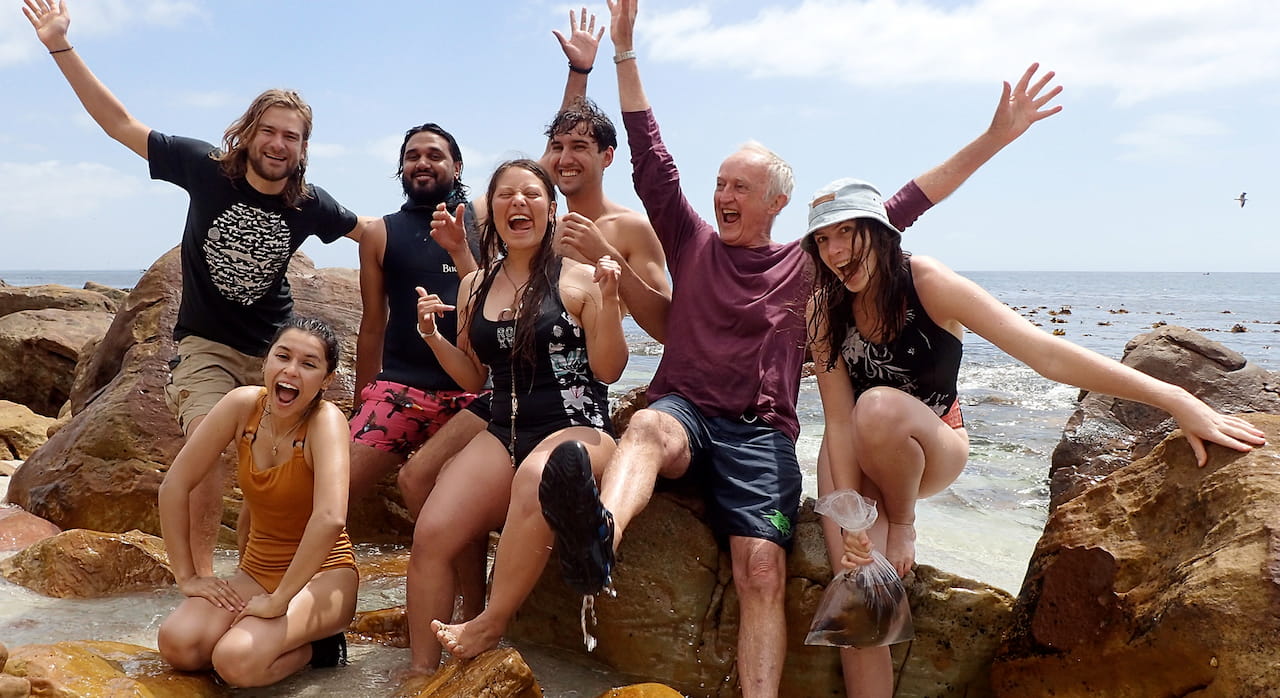Re-searching the Hermit Tanaid
Jannes Landschoff
Research Ideas From Nature
In the research group of my former supervisor Charles Griffiths we often went on intertidal outings with new students. I had had a research question in mind for a while. At one of the sites we regularly visited there was this roundish boulder. When you very carefully lifted that boulder, there were hundreds, if not thousands of small hermit crabs underneath. I was shocked and amazed every single time I looked underneath. I knew there were two different species living underneath it. But I wondered; how many of them are of which species? How do they co-exist in such high numbers so close to each other? Are the two species doing anything different to compete with one other? Are they occupying different shells? And why in this particular spot?
One day I took a sample back to the university. A 2nd-year student called Rouane agreed to help me sort through all the tiny shells. As we went through the samples, we quickly came across something excitingly unexpected. The smallest shells had little crustaceans inside. But they were neither the Pink hermit crab nor the Blue-antenna hermit crab. They were tiny and white, with pincers and a twisted hind body fitting the miniature shells like a hermit crab. At first I thought: “Okay. These must be a kind of hermit crab larvae.” But then we saw that some of them had eggs beneath the body meaning they had to be adults. I could not figure out what they were.
We called our professor to have a look. The moment Charles said, “Oh, this looks like a tanaid!” the penny dropped for me. This was not a crab at all! Tanaids are small, shrimp-like crustaceans. They are a whole different Order in the Class of Crustacea. Perhaps a bit complex to explain in detail, but the two Orders would arguably be as distant to each other as humans would be to giraffes. Both are mammals in the Class of Mammalia but are placed in different Orders. The point being, tanaids are something quite different to a crab. They are common and play an important role in the ocean sediments where they are normally free-living. And yet our ‘hermit tanaids’ were sitting in shells, doing the same thing that hermit crabs do! None of us knew tanaids had such complex adaptations for living in shells.
“The study of such minute creatures opened a new world of colour and shape that still fascinates me. Each organism, some of which could be mistaken for a grain of sand, and each micro-structure is revealed in its place in the natural world through a microscope lens. I am sure every person who looks through a microscope for the first time feels the same. A similar feeling to putting on a mask and snorkel for the first time, diving into the ocean and being able to see the mass of teaming life beneath the surface.”
Rouane
Tiny Crustaceans in the Footsteps of a Giant
We quickly realised that in order to ask ecological questions about this freshly rediscovered hermit tanaid, we first had to solve several challenging questions about its true identity. Walking in the footsteps of Alec Brown and sixty years after his work, the original description was not detailed enough by modern taxonomic standards. Brown only described a single male, not the female or juveniles and surprisingly he did not take note of the unusual hermit crab-like life style of occupying gastropod shells. Also, his drawings were not very good. Had we really rediscovered Brown’s species?
Consequently, this question became Rouane’s project for her B. Sc. (Honours) degree. Rouane went into great detail in her work; one could call it a very deep level of nature tracking. This takes time to learn. The animals are very small indeed, only about 2-3 mm in total length. They can only be looked at under large magnifications. One of the most important discoveries and previously missed by Brown was the existence of so-called ‘sucker-spines’ on the legs which the hermit tanaids use to ‘suck’ onto the shell from the inside. That is how they hold on so tightly. These microscopic structures and many more had to be described and drawn in a meticulous way. Only a fraction of a millimetre, the tiniest mouthparts were dissected. It takes a lot of patience and dedication to acquire these skills and to do this work, particularly when done for the first time. In the end we were certain enough that this really was the same species.
“Illustrating and describing these tiny creatures is my way of exploring and sharing my wonder of our environment. So often overlooked and understudied, the microscopic realm is fundamental in the functioning of the natural world. This is especially true of the marine world where one drop of seawater from False Bay revealed under a microscope appears as busy as a coral reef.”
Rouane
The Global Attempt
“The cool thing about studying marine invertebrate diversity in South Africa is that you can study a single organism for a year and become the national expert. I, as an Honour’s student from the University of Cape Town, was able to present my project at an international biological conference in Hong Kong and be of interest among world-renowned crustacean experts.”
Rouane
From conversations with international experts at the TCS meeting, we realised we had to redo a lot of the work when back in Cape Town and go into even more detail. Rouane had to revisited all the specimens and produce more detailed drawings. We struggled with lots of technical things and we often lacked the right equipment. Our most pressing need was a better stereomicroscope. Lockdown did not help as both the Iziko South African Museum and UCT were closed.
“The challenges were mostly size related; in terms of not enough information on tanaids from South Africa as well as trying to illustrate something less than a millimetre long”
Rouane
Creatures in the Great African Seaforest
“My time in the ocean has a cleansing effect. It gives me the space to get lost in something infinitely larger and more powerful than myself. And I am drawn to understanding that power of life, death and renewal are connected across the planet by water. Studying marine biology makes me feel like an explorer, observing the patterns of the natural world. And as a student of biology, science it gives me a way of communicating what I observe.”
Rouane
One day after we had been in the water, we were sitting at the sampling site rockpool. A few meters away from us lay that special boulder with the thousands of hermit crabs and hermit tanaids underneath. It is a real little community of small, tiny and fragile creatures, with a truly wild existence. All of them are living inside their own little shells, which they swap and share with each other as they grow. It felt like they had guided us to these experiences and to our friendship, taught us and invited us to become a part of their world. It all started with this one boulder. A boulder that was already in existence, and perhaps in the same place, when Alec Brown described the species in 1956. The animals are always present with an inconspicuous subtleness in their habitat where the ocean washes in food and where the greater force of the seaforest intricately connects this parallel world to the large. We only played a small part by writing a short chapter in this infinite story.
Out of curiosity, Rouane and I also looked for the hermit tanaids in other areas and found that they occur all along the Cape Peninsula. As with all my previous projects, the hermit tanaids become an interface of deepest nature connection, a narrowing of and a focusing down into the microscopic as gateway into the larger. Now whenever I go out, I look for these animals. It is an incredibly exciting feeling to come to a new piece of coast, focus in on the small, and realize “Oh wow, they are actually here”. Each time this feels like meeting an old friend for who your heart has already softened. You also know a part of your friend’s life, so you immediately connect to their being. More so, they become a part of you and your life. And through that lens your senses fully open to completely appreciate nature’s beauty. This feeling of deepest primal joy in nature is only multiplied by sharing the passion with your colleagues and friends.
It is difficult to witness the impacts we humans are having on our planet as I understand more and more how fragile and vulnerable life on this planet is and how easily our hermit tanaids and all the other creatures I have studied could vanish for good. A visit to Hong Kong is perhaps the most extreme eye opener. Not that I needed it. These days the challenges are omnipresent.
Foundational Knowledge We Need

“The rediscovery of the hermit tanaid Pagurapseudes dentatus after over 60 years demonstrates how much there is still to explore and understand in the ocean. Picking up a handful of apparent broken shells from under a rock in False Bay revealed a multitude of miniature sea snails, hermit crabs and the forgotten hermit tanaid. I wonder what’s next?”
Rouane
It is my strong belief that we as humans should care about the hermit tanaids of this world. Every animal, plant and organism have their rightful place in nature. And one big part of acknowledging that is through conducting biological research. Only when we know about these animals, only when we do this deep tracking, only when we accumulate knowledge and wisdom around nature can we tell and share our stories. And an organism needs an identity, a name, so that we can talk about it. This is how we function as humans with a culture based in language. Then we relate to the other and form a consensual relationship with and care about nature.
The hermit tanaids now have a scientifically re-established name. It has been a lot of work. I am extremely proud of Rouane and what she has achieved with this project. I am also deeply grateful that we have experienced this incredible journey together and formed such a deep and meaningful friendship along the way. And if there is one thing that I am sure of, it is that there are more chapters to be written. Rouane has now embarked on a new project for her masters, also under my supervision.
Rouane: “I learnt so much from studying a single tiny creature. My taxonomic expertise is now focused on the Mantis shrimps of South Africa, a truly charismatic group of crustaceans. We shall see what new insights there are to discover.”
This story started with a boulder that remains the home to so many animals. It ends with increased curiosity. Because I cannot think of many things that bring as much joy and meaning as the combination of exploring the ocean and sharing a passion for the wild. My goal for Sea Change Science is to expand our biodiversity knowledge, and to run a marine biology lab in which we can do intricate work that continues to decipher the mysteries of the Great African Seaforest. Because each new piece of information brings us more understanding, more care and more love for this fascinating place. Ultimately this passion, this unlocking of foundational knowledge, is the core of all action.
